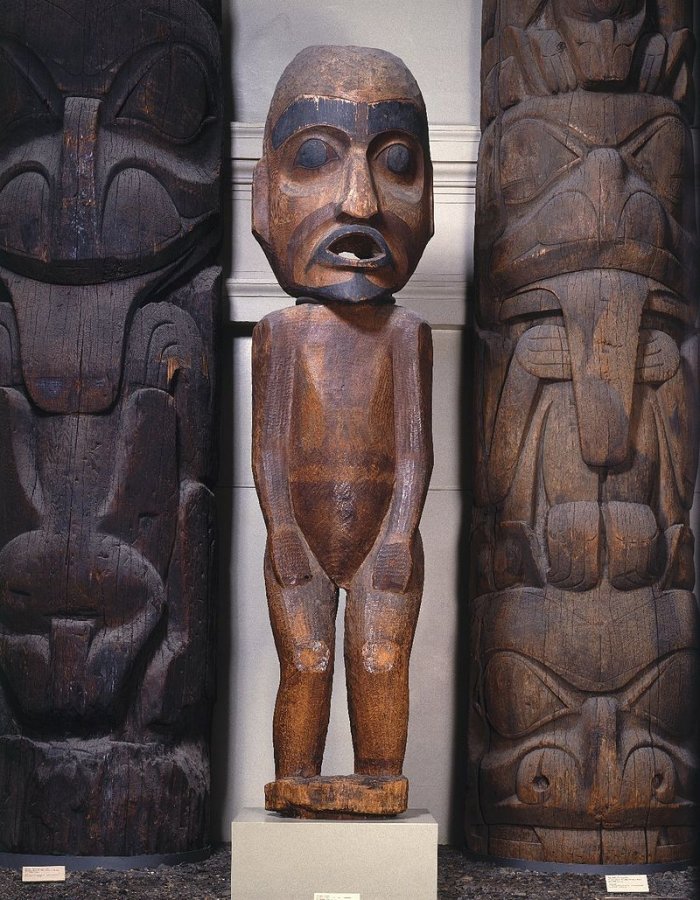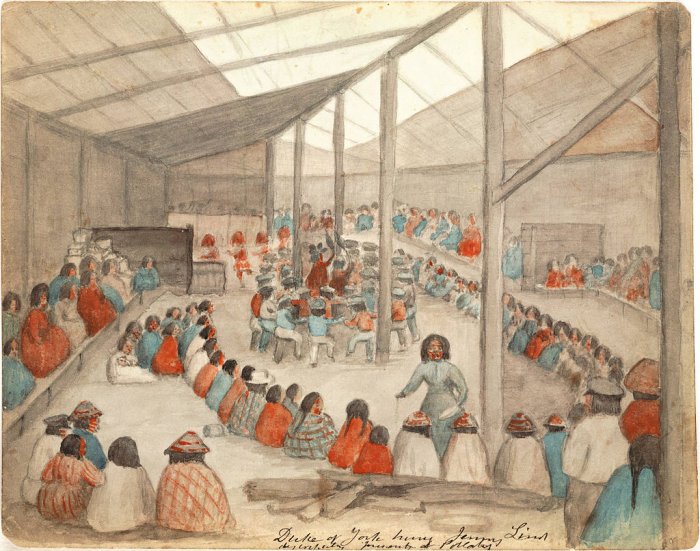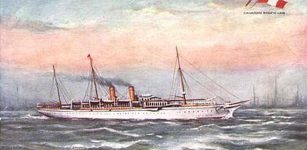Potlatch: Ancient North American Indian Tradition Of Very Generous Gift Giving
AncientPages.com - A Potlatch is an ancient North American Indian tradition of very generous gift giving. A Potlatch was much more than just an ordinary ceremony. Planning a Potlatch could take as long as one year and sometimes even longer.

Speaker Figure, 19th century, Brooklyn Museum, the figure represents a speaker at a potlatch. An orator standing behind the figure would have spoken through its mouth, announcing the names of arriving guests.
The custom was well-known among other ancient civilizations, but the Potlatch custom is mostly associated with Native Americans. It was a ceremonial distribution of property and gifts to affirm or reaffirm social status, as uniquely institutionalized by the American Indians of the Northwest Pacific coast.
The largest Potlatch took place when the queen of Sheba gifted King Solomon 120 talents of gold and the largest quantity of spices ever exchanged at the time.
From 1849 to 1925 the Potlatch reached its most elaborate development among the southern Kwakiutl, North American Indians who traditionally lived in what is now British Columbia, Canada.

Watercolor by James G. Swan depicting the Klallam people of chief Chetzemoka at Port Townsend, with one of Chetzemoka's wives distributing potlatch.
A Potlatch was usually organized because of important events such as marriages, births, deaths, adoptions and initiations into secret societies.
Sometimes trivial events could also result in a Potlatch because the main purpose of a Potlatch was not the occasion itself, but the validation of claims to social rank. The Potlatch was also used as a face-saving device by individuals who had suffered public embarrassment and as a means of competition between rivals in social rank. Only aristocrats could host a Potlatch.
A preparation of a Potlatch involved inviting guests and the size of the gatherings reflected the rank of the donor. Later a speech would be held and the gift giving process started. The distribution of goods by the donor depended on the social rank of the recipients. The proceedings gave wide publicity to the social status of donor and recipients because there were many witnesses. The Potlatch donor strived to be as generous as possible.
For some cultures, such as Kwakwaka'wakw, elaborate and theatrical dances were performed reflecting the hosts' genealogy and cultural wealth. Many of these dances were also sacred ceremonies of secret societies like the hamatsa, or display of family origin from supernatural creatures such as the dzunukwa. According to Kwakwaka’wakw mythology, Dzunukwa is the ‘Wild Woman of the Woods’.
She is often portrayed as an old, unkempt ogress with long, pendulous breasts and wild hair. She is said to snatch up children and carry them home in her basket.
At the end of a Kwakwaka'wakw Potlatch ceremony, the host chief comes out bearing a mask of Dzunuḵ̓wa which is called the geekumhl. This is the sign that the ceremony is over.
From 1884 to 1951 the Potlatches were banned. The Potlatch Ban, which was legislation forbidding the practice of the potlatch was passed by the government of the Dominion of Canada. The Potlatch custom was considered wasteful, reckless and anti-Christian of personal property.
Potlatch was at the heart of a non-Christian cultural system that opposed colonization. Therefore the Potlatch was targeted by missionaries and colonial officials. The Potlatch ban was never entirely effective, though it did significant cultural damage, and continued underground through the period of the ban in a number of places and ways. The Potlatch ban as well as the banning of the Sun Dance and Coast Salish dancing occurred during the height of repressive colonial laws in Canada. In 1951 the Indian Act was amended, removing some of the more repressive measures, including the ban on the potlatch.
After the ban was lifted, Nations on the coast began to openly potlatch again. The revival of open ceremony gained strength during the 1970s and 80s, until it is once again became a widespread and popular tradition.
Copyright © AncientPages.com All rights reserved. This material may not be published, broadcast, rewritten or redistributed in whole or part without the express written permission of AncientPages.com
More From Ancient Pages
-
 Unique Ancient Bronze Miniature Portraits Of Alexander The Great Found In Ringsted On The Island Of Zealand
Archaeology | Apr 11, 2024
Unique Ancient Bronze Miniature Portraits Of Alexander The Great Found In Ringsted On The Island Of Zealand
Archaeology | Apr 11, 2024 -
 On This Day In History: Raid On The Medway Took Place – On June 19, 1667
News | Jun 19, 2016
On This Day In History: Raid On The Medway Took Place – On June 19, 1667
News | Jun 19, 2016 -
 Mystery Of Human Evolution – What Can Ancient Genes Tell Us About Who We Are?
Archaeology | Jun 2, 2022
Mystery Of Human Evolution – What Can Ancient Genes Tell Us About Who We Are?
Archaeology | Jun 2, 2022 -
 Coventry’s Mysterious Ogham Stone Displayed At Herbert Art Gallery And Museum
Archaeology | May 18, 2024
Coventry’s Mysterious Ogham Stone Displayed At Herbert Art Gallery And Museum
Archaeology | May 18, 2024 -
 A 2,700-Year-Old Urartians’ Ayanis Castle And Haldi Temple – Soon An Open-Air Museum
Archaeology | Aug 10, 2020
A 2,700-Year-Old Urartians’ Ayanis Castle And Haldi Temple – Soon An Open-Air Museum
Archaeology | Aug 10, 2020 -
 Puzzling Ancient Artifacts Found In Canadian Mountains Defy Explanation – Scientists Say
Featured Stories | Aug 27, 2024
Puzzling Ancient Artifacts Found In Canadian Mountains Defy Explanation – Scientists Say
Featured Stories | Aug 27, 2024 -
 Cruithne: Legendary King, His Seven Sons And The First Celtic Tribe That Inhabited British Isles
Celtic Mythology | May 27, 2023
Cruithne: Legendary King, His Seven Sons And The First Celtic Tribe That Inhabited British Isles
Celtic Mythology | May 27, 2023 -
 DNA Study Shows Pre-Historic Wallacea Was A Melting Pot Of Human Genetic Ancestries
Archaeology | Jun 9, 2022
DNA Study Shows Pre-Historic Wallacea Was A Melting Pot Of Human Genetic Ancestries
Archaeology | Jun 9, 2022 -
 Sacred Helgafell Mountain And The Story Of Torolv Mostrarskjegg
Myths & Legends | Mar 13, 2024
Sacred Helgafell Mountain And The Story Of Torolv Mostrarskjegg
Myths & Legends | Mar 13, 2024 -
 ‘Yunatsite’ And Thought-Provoking Theory That Balkan Peninsula And Not Mesopotamia Was The Cradle Of Civilization
Featured Stories | Feb 14, 2023
‘Yunatsite’ And Thought-Provoking Theory That Balkan Peninsula And Not Mesopotamia Was The Cradle Of Civilization
Featured Stories | Feb 14, 2023 -
 Sacred ‘Sign Posts’ Of The Inuit People
Ancient History Facts | Sep 4, 2018
Sacred ‘Sign Posts’ Of The Inuit People
Ancient History Facts | Sep 4, 2018 -
 Aqrabuamelu – Mysterious Scorpion Men In Babylonian Mythology
Featured Stories | Jan 19, 2016
Aqrabuamelu – Mysterious Scorpion Men In Babylonian Mythology
Featured Stories | Jan 19, 2016 -
 Legend Of Milky Way’s Celestial Portal And The Star City From The Bowuzhi By Zhang Hua
Chinese Mythology | Feb 14, 2024
Legend Of Milky Way’s Celestial Portal And The Star City From The Bowuzhi By Zhang Hua
Chinese Mythology | Feb 14, 2024 -
 Qilin – One Of Four Noble Animals In Chinese Myths And Legends
Chinese Mythology | Jan 26, 2021
Qilin – One Of Four Noble Animals In Chinese Myths And Legends
Chinese Mythology | Jan 26, 2021 -
 Disgusting Vandalism And Looting Of Viking Graves In Norway
News | Nov 6, 2020
Disgusting Vandalism And Looting Of Viking Graves In Norway
News | Nov 6, 2020 -
 Cosmic Impact 12,800 Years Ago Forced Hunter-Gatherers In The Levant To Adopt Agricultural Practices
Archaeology | Oct 4, 2023
Cosmic Impact 12,800 Years Ago Forced Hunter-Gatherers In The Levant To Adopt Agricultural Practices
Archaeology | Oct 4, 2023 -
 On This Day In History: First US Ship To Trade With China, ‘Empress Of China’ Sails From NY – On Feb 22, 1784
News | Feb 22, 2017
On This Day In History: First US Ship To Trade With China, ‘Empress Of China’ Sails From NY – On Feb 22, 1784
News | Feb 22, 2017 -
 Glooskap (Gluskap): Mythical Hero Who Defeated Evil Sorcerers And Demon Followers
Featured Stories | Jan 25, 2016
Glooskap (Gluskap): Mythical Hero Who Defeated Evil Sorcerers And Demon Followers
Featured Stories | Jan 25, 2016 -
 Archaeologists Uncover Secrets Of ‘Vallø Borgring’ Viking Age Circular Fortress
Archaeology | Oct 11, 2015
Archaeologists Uncover Secrets Of ‘Vallø Borgring’ Viking Age Circular Fortress
Archaeology | Oct 11, 2015 -
 How Strong Is The Link Between Sanskrit And European Languages?
Linguistic Discoveries | Aug 5, 2020
How Strong Is The Link Between Sanskrit And European Languages?
Linguistic Discoveries | Aug 5, 2020

